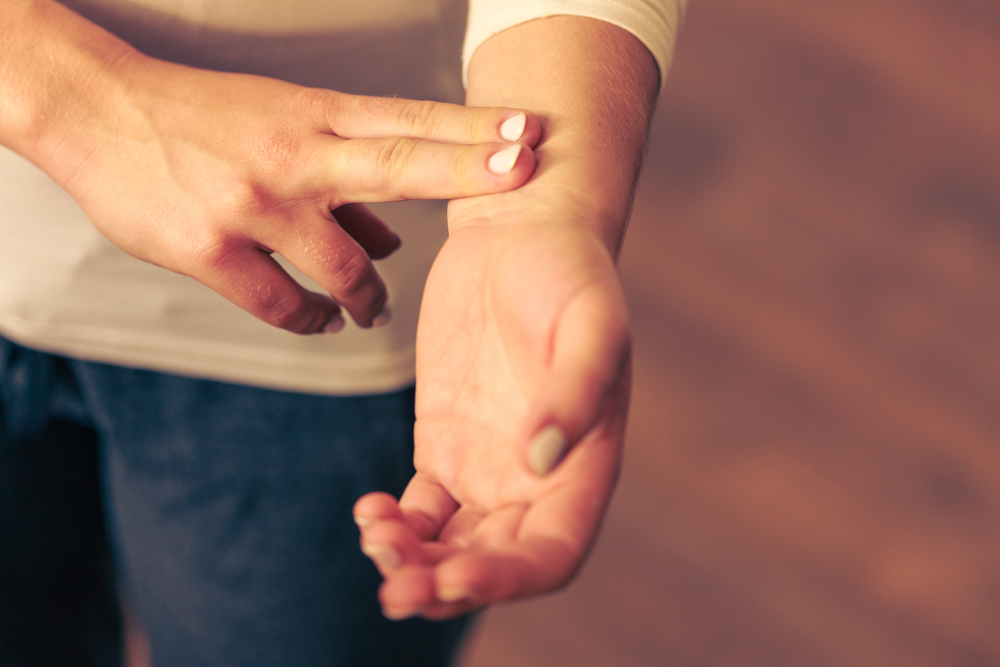WHAT YOUR PULSE CAN TELL YOU ABOUT YOUR HEALTH
An Eastern Medicine Perspective

Did you know that just by assessing your pulse, practitioners can identify the health of your organs and the source of your symptoms?
If you’re new to eastern medicine practices, this method of diagnosis will probably be a whole new concept to you. However, pulse diagnosis has been a regular eastern medicine practice for thousands of years. While any doctor or practitioner will check your pulse during an exam, eastern medicine takes a different, more thorough approach.
In western medicine, the pulse is primarily used to observe the heart rate and regularity. A normal rate is considered to be between 60-90 beats per minute, and a rate that is significantly faster or slower may be a sign of a problem.
In eastern medicine, the pulse is far more of a diagnostic tool. Practitioners observe the pulse to better understand what’s happening internally. Eastern pulse diagnosis can provide insight into internal inflammation, stagnation, excesses, deficiencies, and so much more. They also use pulse to see how the treatment is working in real time.
Let’s take a look…
An Introduction to Pulse Diagnosis
 When beginning a pulse diagnosis, a practitioner will start with three fingers (the index, middle, and the ring finger) placed on the radial artery of each wrist. Each finger is resting on a different part of the pulse (front, middle, and rear). While there are many different systems of pulse diagnosis within eastern medicine, in traditional Chinese medicine we find:
When beginning a pulse diagnosis, a practitioner will start with three fingers (the index, middle, and the ring finger) placed on the radial artery of each wrist. Each finger is resting on a different part of the pulse (front, middle, and rear). While there are many different systems of pulse diagnosis within eastern medicine, in traditional Chinese medicine we find:
On the right wrist – the pulses and the three positions correspond to the lung and large intestines, stomach and spleen, and the kidney (yang) energies.
On the left wrist – the pulses and the three positions correspond to the heart and small intestine, liver and gallbladder, and the kidney (yin) energies.
Each position has three levels (superficial, middle, and deep).
Superficial – almost no pressure in order to feel the rise of the pulse under the skin’s surface
Intermediate – a light pressure that enables you to feel the basic form of the pulse
Deep – heavier pressure to feel how the pulse rebounds from physical constraint
In a pulse diagnosis, a practitioner will assess the pulse length, depth, width, quality, and rate.
Pulse length: Pulse length can identify the strength and balance of blood and energy. It measures whether there is enough blood and energy to adequately push the blood through the vessels. Pulse length is viewed as shorter vs. longer. A practitioner will rest three fingers on your artery to feel for pulse length. If the pulse is not felt under all three fingers, it is considered shorter; if the pulse is longer than the three fingers, it is considered a longer pulse.
A longer pulse could be normal if there are no other signs, but during a pulse diagnosis, many different factors are assessed. The length, width, rate, and quality of your pulse together make up the overall picture.
For example – a pulse that is short AND weak means that the energy is not strong enough to move your blood.
Pulse depth: Pulse depth can identify the different depths of qi (energy) in the body. A superficial pulse corresponds to the skin and wei qi or protective energy, the middle level corresponds to the internal organs, and the deep level represents root energy and energy reserves.
When feeling for depth, a practitioner will first apply almost no pressure at the superficial level, a bit more to the middle level, and the most pressure to the deep level to determine where the pulse is felt.
For example – a pulse felt at the more superficial level is often a sign of an exterior illness, like a cold or flu. A deep pulse shows the state of the organs and more internal conditions.
Pulse Width: The pulse width can identify how much blood is flowing through the vessels. A thin or thready pulse indicates blood deficiency or fluid deficiency. Usually, this is associated with fatigue, weakness, insomnia, nutrient deficiencies, and sub-optimal digestive absorption.
For example – after injury, surgery, or childbirth, a person could have a much thinner width because of depletion or blood loss.
Pulse Quality: Pulse quality is the actual sensation of the pulse, such as being slippery or choppy. There are 28 different pulse qualities.
In eastern medicine, each type of pulse quality relates to a diagnosis, as well as particular physical, mental, or emotional symptoms.
Pulse Rate: Pulse rate can identify heat or cold in the body. A fast pulse, which is more than five beats per breath, indicates excess heat in the body. A slow pulse, which is three beats per breath or less, indicates a cold condition or that something internally is functioning insufficiently.
For example – excess heat in the body could be a sign of fever, an inflammatory condition, or increased stress. Excess cold in the body could be a sign of a blood circulation problem, like cold hands and feet, etc.
A healthy, “normal” pulse
A normal pulse should be felt in all nine positions, it shouldn’t collapse or feel hard. The rhythm of the pulse should be even and balanced and have regular beats. It indicates good heart energy and circulation. Upon deeper pressure, the last position should be easily felt.
Pulse diagnosis is a great way to better understand your health as a whole, as well as get to the root of any health concerns you may be facing. The positions of the pulse don’t just indicate what’s happening, but where it’s happening. Your practitioner will take into account the pulse width, length, depth, and quality, identifying if the organ lacks energy, if the energy is stagnant, if there is a lack of blood, or if a pathogenic factor has invaded the organ. This helps your practitioner get to the root of your symptoms, address any imbalances with the treatment and treatment plan, and help you heal from the inside out.
Newer
5 Things You Can Do Right Now to Boost Your Circulation & Energy Levels
Older
Why You Shouldn't Ignore Nagging Gut Issues
Comments (0)
Leave a reply
You must be logged in to post a comment.




